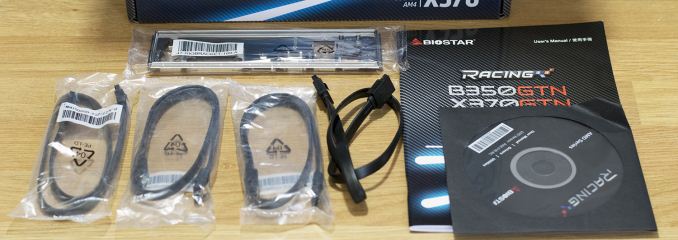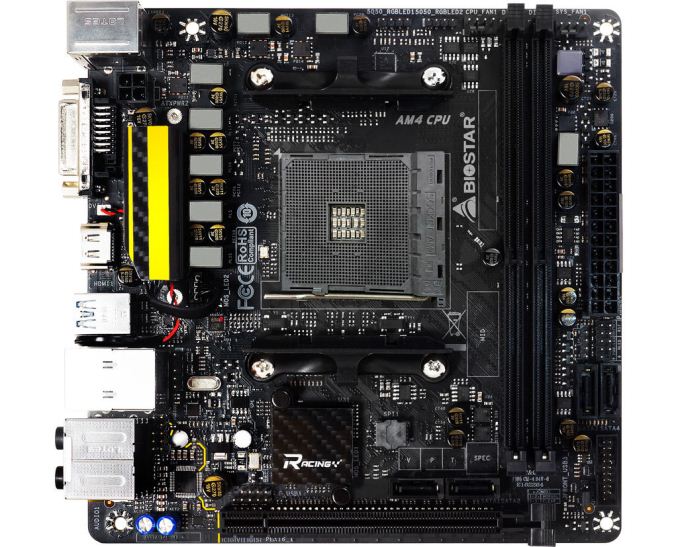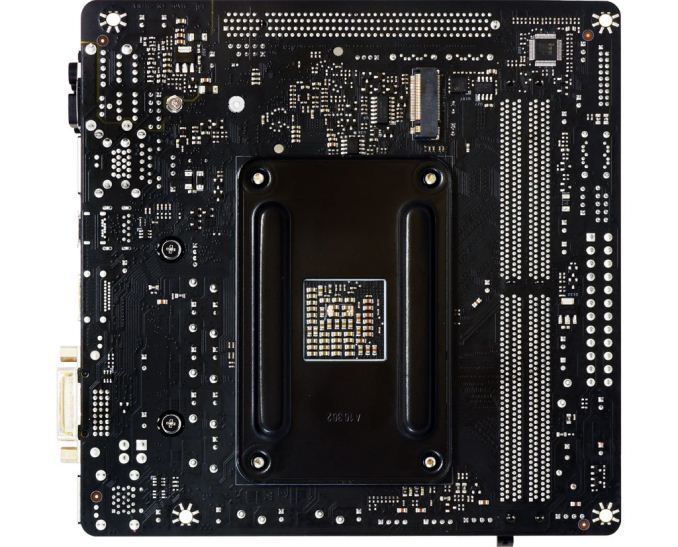The Biostar X370GTN Mini-ITX Motherboard Review: AM4 Goes Tiny
by Gavin Bonshor on October 23, 2017 9:00 AM ESTBoard Features
Biostar wasn’t just the first manufacturer to release and produce an ITX motherboard for the AM4 platform, but the X370GTN is one of the cheapest X370 boards on the market. One of the benefits that some vendors are exploiting is that users can build a small and affordable system with 8-core processors with Ryzen, although few are reluctant to go into the mini-ITX form factor.
| Biostar X370GTN Mini ITX Motherboard | |
| Warranty Period | 3 Years |
| Product Page | Link |
| Price | $110 |
| Size | Mini-ITX |
| CPU Interface | AM4 |
| Chipset | AMD X370 |
| Memory Slots (DDR4) | Two DDR4 Supporting 32GB Dual Channel Up to 3200 MHz |
| Video Outputs | HDMI 1.4 DVI-D |
| Network Connectivity | Realtek RTL8118AS |
| Onboard Audio | Realtek ALC892 |
| PCIe Slots for Graphics (from CPU) | 1 x PCIe 3.0 (x16) |
| PCIe Slots for Other (from PCH) | None |
| Onboard SATA | Four, RAID 0/1/10 |
| Onboard M.2 | 1 x PCIe 3.0 x4, on Rear |
| USB 3.1 (10 Gbps) | 1 x Type-C 1 x Type-A |
| USB 3.0 (5 Gbps) | 4 x Rear Panel 1 x Header |
| USB 2.0 | 2 × via header |
| Power Connectors | 1 x 24-pin ATX 1 x 4-pin CPU |
| Fan Headers | 1 x CPU (4-pin) 1 x System (4-pin) |
| IO Panel | 4 x USB 3.1 (USB 3.1 Gen 1) 1 x USB 3.1 (USB 3.1 Gen 2) 1 x USB 3.1 Type-C 1 x Network RJ-45 1 x DVI-D 1 x HDMI 1.4 1 x Combo PS/2 5 x 3.5 mm Audio Jacks 1 x Optical SPDIF Out Port |
The size of the motherboard means that there is only two memory slots, although Biostar lists these as supporting up to DDR4-4000. Although RGB does not enhance performance, it is a popular feature (especially for marketing), and the X370GTN has an RGB header that is controllable through software as well as some embedded LEDs on one of the heatsinks.
In The Box
We get the following:
- Four black SATA cables
- User manual
- Driver installation disk
- I/O shield
Inside the box, we have the minimum number of accessories which you would expect to find with any motherboard. This includes four black straight SATA cables, one for every SATA port. If Biostar were going to plug the 'gaming' aspect of the package, we might have expected something a little extra here, however, the cost is also a factor.
Visual Inspection
The X370GTN features a fairly basic layout, with an all-black PCB and a pair of small racing styled heat sinks, one covering the power delivery and one on the chipset. The power delivery heatsink is small and contains a wave of RGB LED lights integrated into it. While this heatsink manages to cover what is intended, the size seems relatively inadequate and it doesn’t have much mass to it. The chipset heatsink is also light, to which Biostar are using push pins for mounding and equipped it with a subtle carbon effect wrapper to enhance the look.
There are only two fan headers on the board, found either side of the two memory slots. This used to be normal for mini-ITX motherboards, although recently the main manufacturers have started supporting three as a standard. Looking to processor power connectivity, only a single 4pin 12V power connector is required to power the board. This is more than capable of running any Ryzen CPU at stock, but might not be sufficient for large overclocks.
A noticeable feature on the Biostar board is the use of 5k rated solid state polymer capacitors, which is a little disappointing. Most AM4 motherboards usually have 10k or 12k rated caps, which corresponds to their longevity. These caps are unmarked/unbranded, so it is unclear where Biostar is sourcing them from. At the bottom end of the motherboard, Biostar has equipped four SATA ports, with two of them running parallel above the single PCIe x16 slot, and the other two next to the memory slots. Also in this area are a pair of USB front panel headers, with one for USB 3.0 (5 Gbps) and the other for USB 2.0.
The board has a 4+3 phase power delivery design, which is typical given the size of the board and price point. The X370GTN features seven ER30 1712 Ferrite chokes, seven NIKO Semiconductor MOSFETs and is controlled by the Intersil ISL95712. The 4+3 phase is split into two separate sections with four being dedicated to the CPU, with the other three likely in place for upcoming APUs (Ryzen with bundled graphics).
On the rear panel, we find a four USB 3.0 (5 Gbps) ports, and two USB 3.1 (10 Gbps) ports, with the latter having a Type-C and Type-A. The Realtek Dragon networking chip provides the gigabit networking port, while the Realtek ALC892 provides the audio jacks. A PS/2 combo port is also present, and video outputs are a single DVI-D connector, supporting resolutions of up to 1920 x 1200 @ 60Hz, and a sole HDMI 1.4 output supporting 3840 x 2160 @ 30Hz. These video outputs are for users who are investing in the current Bristol Ridge APUs, or looking to potential future APUs supported on the platform.
Even though the rear PCB of the Biostar X370GTN is mostly covered up by the AMD cooler installation backplate, Biostar has included a single PCIe 3.0 x4 M.2 port to the rear. When using the M.2 port in PCIe mode, Ryzen processors will offer a maximum bandwidth rate of up to PCIe 3.0 x4, while Bristol Ridge APUs allow for up to a maximum of PCIe 3.0 x2. Both 2260 and 2280 sized options featuring M key type connectors are supported by this board.















31 Comments
View All Comments
wolfemane - Monday, October 23, 2017 - link
Thanks for getting to these little units! The AM4 itx has been a fairly limited product. With gigabyte, asrock, and biostar being the only ones to have boards out. I know Asus was releasing boards today (but haven’t seen them for sale yet).Would be nice to see a more in depth look at the power delivery system on these boards. I’ve been using the gigabyte board and it has unbelievable bad voltage control. With cpu voltage set to 1.325v for a 3.85ghz OC, and a low offset I expected no more than .5v over. But I see voltage bounce to 1.58v using HWMonitor. And temps are beyond scary on the vrm’s. Even with a fan directly blowing air over the vrm’s HWMonitor reports ~120c under full load at the mentioned voltage.
I’ve also been a little disappointed in rear I/o availability across the boards, and the Asus boards look to be the worst. I’m also quite surprised to see the lack of the new usb 3.1 gen 2 motherboard connector on any of these boards.
DanNeely - Monday, October 23, 2017 - link
Yikes! That much deviation sounds like a defect - hopefully just software and thus easily fixable - I'm surprised voltages that high haven't bricked anything. >1.5v is generally only safe with something cooling the chip below ambient temperatures.wolfemane - Monday, October 23, 2017 - link
I should have stayed that was with a 1700x.I’ve seen peaks of 1.68v. I’ve actually contacted gigabyte several times and have received no response back. Latest bios did nothing to bring this under control.
I’ve actually sully contacted gigabyte a couple of times and have received no response. I was going to place an Rma on the board but I’ve ran across some posts on various forums who experience this issue as well. So I’m kinda suspecting it’s a problem with the board.
HWMonitor has reported voltage max values upwards of 1.68v when I was trying to push 4.0ghz. That’s with a set value of 1.375v and the same low setting offset. After a week of testing and putting it through the works I wound up reverting back to default settings and then undervolting it... which strangely lead to slightly higher turbos and faster overall exporting times from premier (which I don’t understand).
DanNeely - Monday, October 23, 2017 - link
The latter sounds like the stupidly high voltages were causing thermal protect circuity to intervene and drop your voltage/clocks briefly to prevent the CPU from cooking itself.wolfemane - Monday, October 23, 2017 - link
Yes! That was the first thing I thought of as well. But when I went back to review the data I collected, cpu temps were all reporting below thermal maximums and verified using ryzen master software. Data collected from HWMonitor. I also didn’t see any cpu throttling when I ran aida64’s stress test. So either I’m reading the data incorrectly (which wouldn’t surprise me) or I’m just plain missing something (which would also not surprise me). Either way the system runs better at stock settings with under volt settings.Was hoping the Asus boards would be made available today. Would like to swap boards and do my own testing all over again to see what the results would be in comparison.
LeahFleming - Monday, October 23, 2017 - link
I resigned my office-job and now I am getting paid £64 hourly. How? I work over internet! My old work was making me miserable, so I was forced to try something different, two years after...I can say my life is changed-completely for the better!Check it out what i do... http://cutt.us/EnRTV
Brother Ali - Thursday, October 26, 2017 - link
I have the asrock itx B350 and a 1600. I have my voltage set to 1.375 in the bios. In HWMonitor its .384V-1.392V; stays at 1.392V consistently. If ASUS doesnt work out consider asrock, ive been very happy with it so far.Samus - Monday, October 23, 2017 - link
I don't get it. If you are going to build an ITX board, you are clearly going for a niche market where price isn't as sensitive to the potential buyer. So why cheap out on shit like an ALC892? To further exacerbate the problem, since it is ITX, it is inherently not upgradable since there is no room for expansion.This board is BIOdegradable. Asus and ASrock are doing a substantially better job at outfitting their boards with more premium components. You'd be a sucker to buy something like this for a system when you could get a premium board for 20% more.
lmcd - Tuesday, October 24, 2017 - link
The BioStar was released prior to availability of the B350 chipset. The ASRock using the X370 chipset costs $150, a substantial amount more than this board.sonny73n - Tuesday, October 24, 2017 - link
In my years of building rigs, Gigabytes had the worst voltage control for the CPU. Moreover, their boards' bios and softwares were behind their competitions and weren't working too well. It seems they haven't improved in the last few years. My advice to anyone who plans to overclock - avoid Gigabytes.